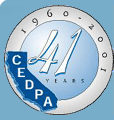

DataBus - Vol 41 No. 4: June-July, 2001
|
Technology Literacy Challenge Grant Spotlight on: Grant Coordinator's Collaboration
As part of the accepting Technology Literacy Challenge Grant funds, recipients agreed to attend a minimum of one grant coordinators' meeting per year. Funds from the grant were budgeted to cover the expense of the meeting, cost of the travel, and per diem. The last meeting before the Technology Literacy Challenge (TLC) grant close out this year was held on May 10, 2001. Desert Sands Unified, located in La Quinta, California was the high-tech setting for the final TLC meeting. The district prides itself on the microwave connections that make using the Internet a quick and easy process. As Dr. George Araya, Director of Technology, noted during his PowerPoint presentation, if a runner was used to represent the speed of the average modem (6 MPH) and a 747 to represent the T-1 (625 MPH), microwave would be represented by the space shuttle (3,850 MPH). Doris Wilson, Superintendent of Desert Sands Unified, warmly greeted the TLC meeting participants, assured us we would not be subjected to rolling blackouts, and made a convincing pitch for recruitment of tech-savvy leaders for her district. Over 150 attendees that included superintendents, principals, technology coordinators, teachers, media specialists, and grant administrators braved 106 degree heat to meet, talk, collaborate, learn about grant close-out procedures and new funding opportunities. Gracious staff from Desert Sands Unified (including Sue Cox, Tanya Carter and Matt Blansett, among others) helped keep the technology humming and the meeting moving in a positive direction. Besides information on legislation, statewide technology services, and the TLC grant provided by staff from the California Department of Education, Susan Radke from the Berkeley Geo-Research Group gave a presentation on Geographic Information System (GIS) and how to incorporate GIS into math, science, and language arts. She provided all attendees with a CD containing free data sets and lesson ideas for using GIS with students. Breakout sessions during the day ranged from hands-on activities, such as non-linear digital video editing, handheld computers and probes to web-based collaboration and communication tools. Beaumont Unified School District brought its traveling technology bus, complete with work and presentation stations, and shared the process of development from artist sketches to implementation, <http://www.beaumontusd.k12.ca.us/tlc_grant.htm>. Dr. Becky Howery, from Desert Sands Unified, shared two programs in which students in that district are actively involved in assisting the district with networking issues, < http://www.dsusd.k12.ca.us/users/Becky/Networking/Home.htm>. Towards the end of the day, a TLC issues session was held. Scott Smith from Visalia Unified School District provided information about lifetime staff development. Other issues' sessions included what legislators should know about educational technology, staffing after the TLC grant ends, the best way to provide technical support, and future rounds of TLC funding. Discussions were both lively and informative. After the TLC meeting ended, we were invited by our host district to a technology fair for elementary students held at La Quinta High School. Those TLC participants who were able to attend the technology fair expressed their delight at seeing multimedia projects that were ably created and explained by students as young as second grade. Projects ranged from chronicling the Gold Rush and the transcontinental railroad via the Internet to detailed PowerPoint presentations on subjects ranging from the endangered Desert Tortoise to local Native American tribes' history. Maybe we'll see some of these presented at the next Student Technology Showcase in March, 2002! <http://www.cde.ca.gov/showcase>.
Dr. Joyce Hinkson is an Education Programs Consultant for the California Department of Education's Education Technology Office. She may be reached at (916) 323-2241 or by e-mail at
|
CEDPA